

Executive

How to Elect
President, Governors &
District Mayor

Presidential form of
federal, Provisional
& district government
THE 1973 CONSTITUTION IS NOT PROVIDING POLITICAL JUSTICE. FAILED TO BRING POLITICAL STABILITY IN THE PAST 47 YEARS
In the 1973 Constitution, Article 2(a) states that the state “wherein shall be guaranteed fundamental rights including equality of status, of opportunity before law, social, economic and political justice, and freedom of thought, expression, belief, faith, worship and association, subject to law and public morality.”
- If people of a country don’t have political justice, then they will not get economic and social justice. Consequently, the country will not get political, economic, and social justice internationally.
- Political justice was denied to the people of Pakistan since 1970 because they were ruled by political parties who got less than 51% of the popular vote.
- In the parliamentary system, we elect legislators, but they also become executives. So people of Pakistan denied political justice to elect the right people for the right job.
- In the parliamentary system, the people of Pakistan do not have the right to directly elect their senators. The senate does not possess any power in the 1973 constitution, making the union between provinces weaker.
- The special seats of Parliament (about 20%) are completely unjust to the system.
- Independent members of Parliament have sold their loyalties against the will of their voters.
- By-elections are another useless practice
- The Parliamentary system encourages polarization in a society like Pakistan which is divided by language and religious sects.
FEDERAL GOVERNMENT OF PAKISTAN
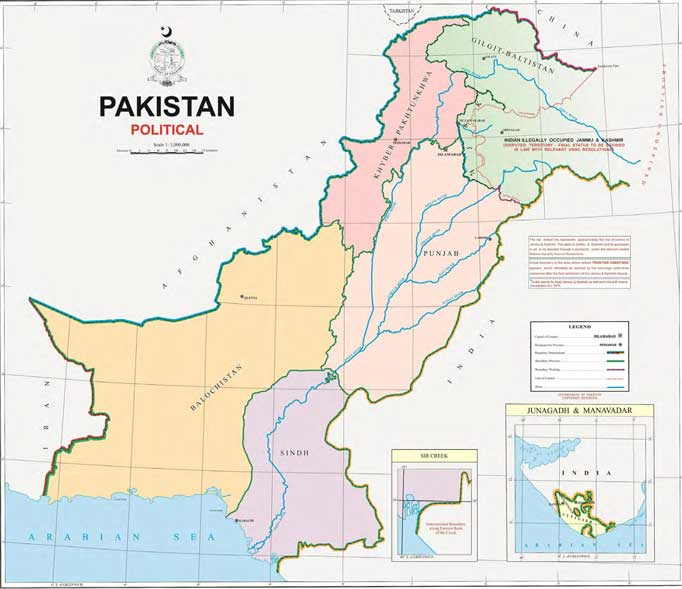
POPULATION OF PAKISTAN INCULDING KASHMIR: 220 MILLION
REGISTERED VOTERS INCLUDING KASHMIR: 113 MILLION
PRESIDENT AND VICE PRESIDENT WITH 20 CABINET MEMBERS
PRESIDENT REQUIRE MORE THAN 50% OF TOTAL CAST VOTES
THROUGHOUT PAKISTAN AND AT LEAST 3 PROVINCES.
KASHMIR AS A 5TH PROVINCE OF PAKISTAN
Kashmir will be provisionally given status equal to a province of Pakistan, subject to the settlement of the Kashmir dispute in accordance with UNCIP Resolution.
It should include:
OPTION 1: GILGIT BALTISTAN, AZAD KASHMIR, SRINAGAR VALLEY, + JAMMU & LADAKH
OPTION 2: GILGIT BALTISTAN, AZAD KASHMIR, SRINAGAR VALLEY

EXECUTIVE & LEGISLATIVE SUMMARY (4 YEAR TERMS)
| Executive & Legislative | Fixed Cabinet Members | Details |
| President, Vice President | 20 ministers | 4 ministers from each province |
| Governor, Deputy Governor | 10 ministers | - - - - - - |
| District Mayor, Vice Mayor | 5 commissioners | - - - - - - |
| Senate | 100 senators | 20 senators from each province |
| National Assembly | 300 MNAs | 1 MNA seat/700K population |
| Provincial Assembly | 600 MPAs | 1 MPA seat/350K population |
| LIST1: PRESIDENT AND VICE PRESIDENT WITH 20 MINISTERS *4 YEAR TERM | |
| 1. Foreign Affairs | 11. Education |
| 2. Defense | 12. Labor |
| 3. Interior | 13. Water |
| 4. Finance & Planning | 14. Energy |
| 5. Justice & Law | 15. Science & Technology |
| 6. Industry and Commerce | 16. Railways |
| 7. Food and Agriculture | 17. Ports |
| 8. Natural Resources | 18. Airports |
| 9. Housing | 19. Highways |
| 10. Health | 20. Environment |
PROVINCIAL GOVERNMENT
| LIST2: 4 YEAR TERM - Governor and Vice Governor with 10 Ministers |
| 1. Education |
| 2. Health |
| 3. Housing |
| 4. Agriculture/Irrigation |
| 5. Unemployment/Welfare |
| 6. Industry |
| 7. Mining |
| 8. Finance |
| 9. Interior |
| 10. Law & Prosecution |
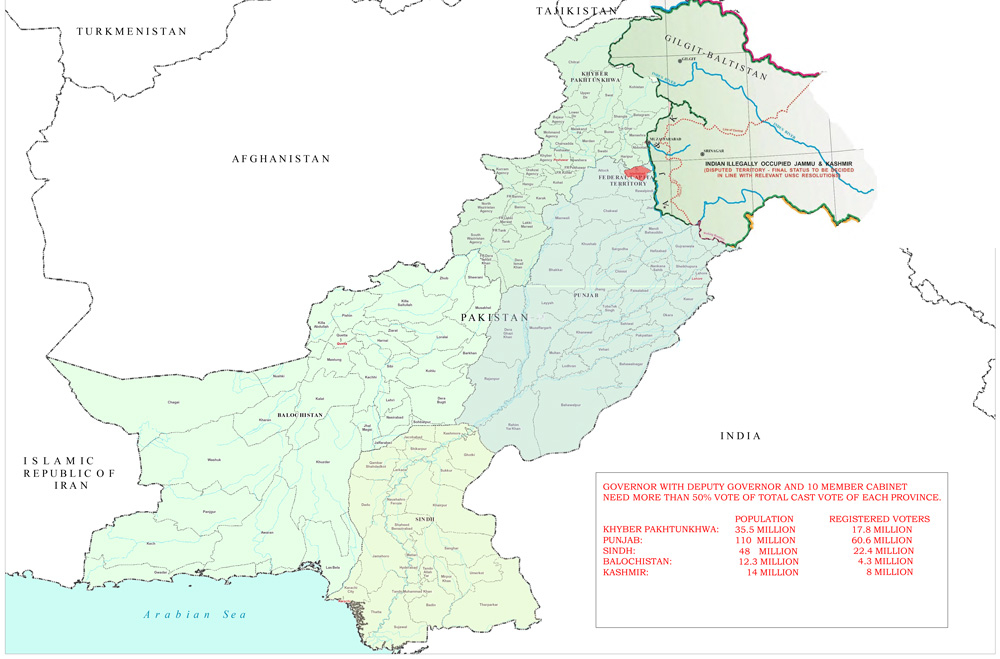
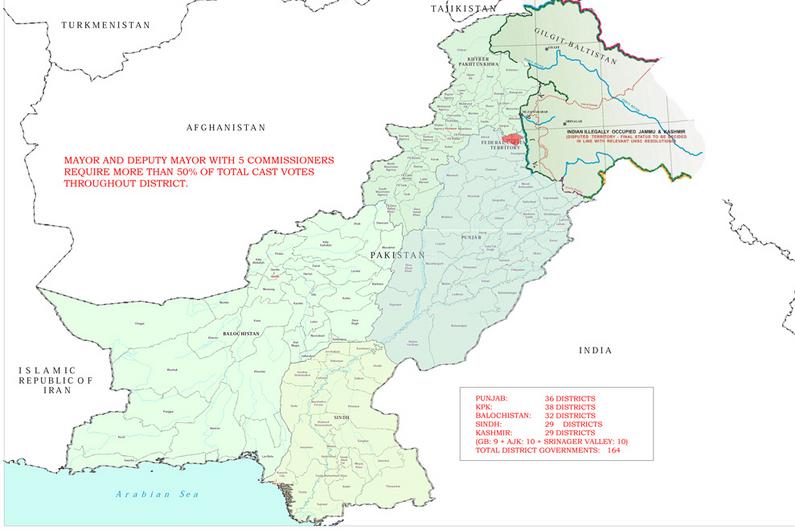
| LIST 3 *4 YEAR TERM District Mayor and Vice Mayor with 5 commissioners |
| 1. Police |
| 2. Land, Town Planning, Building, Water, Sewage, & Sanitation |
| 3. Emergency Services |
| 4. Education |
| 5. Health |
ELECTION COMMISSION WILL DECIDE WHICH PARTY WILL BE ON THE BALLOT ONE YEAR BEFORE THE ELECTION DATE.
Each political party on the ballot will give the election commission the following names and lists 90 days before the election date. Following scrutiny, the election commission will publish the names and lists 60 days prior to the election:
1. President & Vice President with 20 member cabinet. (4 members from each province).
2. Governor & Deputy Governor with 10 member cabinet.
3. District Mayor & Vice Mayor with 5 commissioners.
4. Priority list of Senators for each province.
5. Priority list of MNAs and MPAs for each district.
POLITICAL PARTIES ON BALLOT FROM 2018 ELECTION (COULD BE POTENTIAL POLITICAL PARTIES FOR PRESIDENTIAL ELECTION)
| S.No. | Party Name | Party Flag | Votes | % |
| 1 | PTI |
 |
16.9M | 31.82 |
| 2 | PML(N) |
 |
12.9M | 24.35 |
| 3 | PPP |
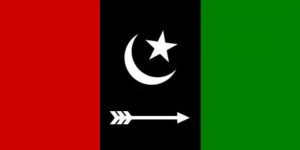 |
6.9M | 13.03 |
| 4 | JUI |
 |
2.7M | 4.85 |
| 5 | TLP |
 |
2.2M | 4.21 |
| 6 | GDA |
 |
1.2M | 2.37 |
| 7 | ANP |
 |
0.8M | 1.54 |
| 8 | MQM |
 |
0.7M | 1.38 |
| 9 | PML (Q) |
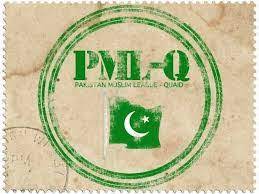 |
0.5M | 0.97 |
| 10 | BAP |
 |
0.3M | 0.60 |
| 11 | BNP |
 |
0.2M | 0.45 |
| 12 | JWP |
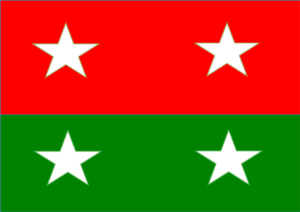 |
- | - |
| 13 | PAT |
 |
- | - |
| 14 | JI |
 |
- | - |
NOTE: ELECTION COMMISSION CAN DECIDE TO ADD MORE PARTIES OR ELIMINATE FROM CURRENT BALLOT, BUT THE MAXIMUM PARTIES TOTAL SHOULD BE 14.
- Voters will cast their votes for a political party. If the presidential, gubernatorial, and district mayoral candidates do not obtain 50% or more votes of the total votes in their respective constituencies, then a second round with the top two candidates will be held 30 days later, and the remaining candidates will be removed from the ballot. In the second round, the candidates may change their cabinet list within 7 days before elections. President must obtain 50% or more of votes not only throughout Pakistan but also in 3 provinces.
- The second round will not affect the voting results of senators, MNAs, and MPAs. These results will be calculated in only first round.
- Only twelve political parties should appear on the ballot. Although there are about 100 registered political parties in Pakistan, every party should not appear on the ballot. It makes the ballot paper both extremely long and confuses the voters. There are really only ten political parties who have a presence in Parliament. There are two emerging political parties whose future popularity is evident. The Election Commissioner will determine which parties will appear on the ballot at least one year prior to the election. The decision will be based on the number of votes a party received in the past election and for a new party on the basis of real membership.
- In case of the President’s death, resignation, or disqualification, the Vice President will become President for the remainder of the term and the new President may nominate a new Vice President within 3 days.
- In case of the Vice President’s death, resignation, or disqualification, the President will nominate a new Vice President within 3 days.
- In case of both the President and Vice Presidents’ deaths, the Senate Chairman will become President and will nominate a Vice President within 3 days. The Senate will elect a new chairman within 3 days.
- The Federal Cabinet will remain intact and effective in all circumstances mentioned above until the President wants to change any members. If the President removes any cabinet member, s/he is bound to appoint a new member within 3 days.
- In case of the Governor’s death, resignation, or disqualification, the Vice Governor will become Governor for the remainder of the term and the new Governor may nominate a new Vice Governor within 3 days.
- In case of the Vice Governor’s death, resignation, or disqualification, the Governor will nominate a new Vice Governor within 3 days.
- In case of both the Governor and Vice Governors’ deaths, the Speaker of Provincial Assembly will become Governor and will nominate a Vice Governor within 3 days. The Assembly will elect a new speaker within 3 days.
- The Provincial Cabinet will remain intact and effective in all circumstances mentioned above until the Governor wants to change any members. If the Governor removes any cabinet member, s/he is bound to appoint a new member within 3 days.
- In case of the District Mayor’s death, resignation, or disqualification, the Vice District Mayor will become District Mayor for the remainder of the term and the new District Mayor may nominate a new Vice District Mayor within 3 days.
- In case of the Vice District Mayor’s death, resignation, or disqualification, the District Mayor will nominate a new Vice District Mayor within 3 days.
- In case of both the District Mayor and Vice District Mayors’ deaths, the head of that political party will appoint a new District Mayor and Vice District Mayor from that district within 3 days.
- The district commissioners will remain intact and effective in all circumstances mentioned above until the District Mayor wants to change any members. If the District Mayor removes any commissioners, s/he is bound to appoint a new member within 3 days.
- There will be no election for President, Vice President, Governor, Vice Governor, District Mayor, or Vice District Mayor for the remainder of the term.
LEGISLATIVE
How to elect SENATOR’s, MNA’s and MPA’s
The Senate
- There will be one hundred senators in Pakistan. Each senatorial term will be 4 years.
- Sindh: 20 senators
- Balochistan: 20 senators
- Punjab: 20 senators
- Khyber Pahktunkwha: 20 senators
- Kashmir: 20 senators
Note: The system will not allow any individual candidate to contest the Senate election. There will be no special seats in the Senate.
There will be no seats from Islamabad. (Islamabad is not a province. Therefore, it should not be represented in the Senate.)
- The number of senate seats given to a political party will be determined based on the percentage of votes received by a party (out of the total number of casted votes) on a provincial level.
- Political parties who receive less than five percent of the total number of votes will not be allotted any senate seats. The votes of that party will not be counted in the total number of votes.
- Each political party will provide the Election Commission with a priority candidate list of senators for each province which is restricted from being taken one candidate from one senate constituency as mentioned in the map. Party is not bound to give twenty candidates names, they can give less than twenty, what is the party’s capacity.
The lists should be provided ninety days prior to the election. The Election Commission will scrutinize and approve the lists within thirty days. The lists should be made public sixty days prior to the election
- Candidates can only seek a Senate seat from the same Province in which they reside and have domicile.
- When a new Senate is elected, the current Senate is considered to be completely dissolved.
- The Following needs Senate Approval:
- Money Bills
- Military Operations and Wars
- Major International Treaties (value greater than 500 million USD)
- Major dams, ports, highways and new military bases
- Oil, gas and other major mineral exploration projects
- Federal Secretaries
- Chairpersons of Public Sector Enterprises
- Chief Election Commissioner
- Attorney General
- Auditor General
- Accountant General
- Head of Accountability Bureau
- Head of FIA and IB
- All Senate decisions require at least 51 votes of the total 100 votes for approval. The above-mentioned positions will be appointed by the President. Nominees will be interviewed and approved in a live televised hearing held by a Senate committee containing equal representation from each province.
- In case of a senator’s death, resignation, or disqualification, the election commission will notify within 3 days the next senator from the priority list of that political party.
- There will be no by-election for senator for the remainder of the term.
- Senators have no role in executive affairs. Their role is strictly in legislation at the national level. This will set a trend where only educated individuals and experts have an interest in becoming Senators.
Election of the National Assembly (MNA’s) and the Provincial Assembly (MPA’s)
*Each term is 4 years
- The number of MNA and MPA seats allotted to a district will be determined based on the population of that district. For example, a district with a population of about 700,000 people should count towards one MNA seat and two MPA seats. A district with a population of 7,000,000 people will have ten MNA seats and twenty MPA seats.
- In total, there should be 300 MNAs and 600 MPAs for all provinces.
- Each political party will provide the Election Commission with a candidate list of MNAs and MPAs for each district. The lists should be provided ninety days prior to the election. The Election Commission will scrutinize and approve the list within thirty days. The lists should be made public sixty days prior to the election.
- The system will not allow any individual candidate to contest the election of MNAs and MPAs. There will be no special seats in the National and Provincial Assemblies.
- Political parties are not allowed to list an individual more than once. Candidates may only appear on the list of one district. Also, an individual can only be listed as a candidate for one government position (Senator or MNAor MPA)
Election of MNAs and MPAs On the Basis of Proportional Representation at the District Level
- If a party gets less than ten percent of the total cast vote in a district, then the votes it has accumulated will not be counted. The political parties will get MNA and MPA seats on the basis of percentage votes which they obtain from the districts.
- Logically, there will be no independent and special seats in this system of proportional representation. There will be no controversey in determining the boundaries of a constituency because the district boundaries are already marked.
- By keeping the system of proportional representation at a district level, the spirit of a representational system is maintained. If the votes for each political party were counted at a national level, then this spirit could not exist.
- If during a term, an elected candidate resigns or dies or disqualifies, the election commission will notify the next candidate from the priority list within 3 days.
- MNAs and MPAs have no role in executive affairs. Their role is strictly in legislation at the provincial and national levels. This will set a trend where only educated individuals and experts have an interest in becoming an MNA or MPA.
Judicial
Three types of Courts

Constitutional
Supreme Court of
Pakistan
11 Judges

Provincial
Supreme Court
625 Judges

District
Supreme Court Bench
4,400 Judges
There will be 11 Judges in the Constitutional Supreme Court of Pakistan. (Two from each province and one from Islamabad). These will be appointed by President and will be approved by Senate.
The role of the Constitutional Supreme Court of Pakistan will be to:
- Interpret the Constitution
- Refer to Parliament for legislation in any matter regarding the improvement of the Constitution and the law.
- Matters between the Federal Government and the Provinces.
- Matters between the Provinces.
- Judges of the Provincial Supreme Court will be appointed by the Supreme Court of Pakistan.
Constitutional Amendment
- Any citizen of Pakistan has a right to file a petition in the Constitutional Supreme Court of Pakistan (CSCP) to challenge any clause of the constitution of Pakistan or the law of Pakistan which he or she feels are against the Quran and Sunnah.
- It will be the discretion of the Supreme Court of Pakistan to accept any petition. If the CSCP accepts a petition for hearing, then the CSCP is bound to form a full bench and make a decision on the case within a 100 days of accepting it.
- The role of the CSCP will not be legislative. Instead, the CSCP will refer the decision to Parliament for proper legislation. This will either be an amendment to the Constitution or a law in a specific time period.
- Parliament/Government will be bound to act upon the CSCP decision in letter and spirit. If the government is unable to pass legislation, they have the option to have a referendum on that matter within ninety days of the decision. If the matter is approved by referendum, it will automatically become an amendment in the constitution or a law. If the referendum is not approved, the Supreme Court decision is null and void.
Each province will have its own Supreme Court. Hence, there will be five Supreme Courts

Punjab
Supreme Court
Number of Judges:
300

Sindh
Supreme Court
Number of Judges:
150

Baluchistan
Supreme Court
Number of Judges:
25

Khyber Pakhtunkhwa
Supreme Court
Number of Judges:
100

Kashmir
Supreme Court
Number of Judges:
50
These courts will only accept appeals against the decisions of district Supreme Courts. These courts are bound to give their decisions within six months. Their decisions will be final in any criminal and civil matters. There will be no appeal to the Constitutional Supreme Court of Pakistan.
Each district will have benches of the Supreme Court. The number of benches in a district will depend upon its population.
A population of fifty thousand should have one bench of the Supreme Court. The district Supreme Court benches are bound to give their decisions for criminal matters within six months and for civil matters within one year. In criminal matters, the district government will be the prosecutor, bound to act within the time limit of six months.
There will be a total of 4,400 Judges in all the districts on a population of 220 million people and these will be appointed by provincial Supreme Courts.


